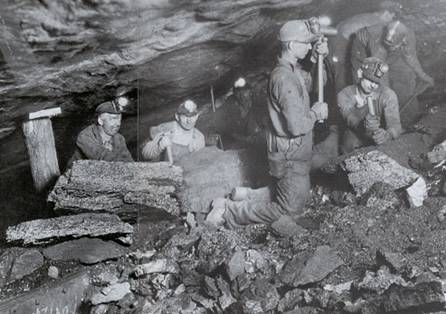
THE VOICE OF INTERNATIONAL LITHUANIA
|
VilNews has its own Google archive! Type a word in the above search box to find any article.
You can also follow us on Facebook. We have two different pages. Click to open and join.
|
Fleeing from domestic famine in the late 1800's:
Hordes of Lithuanians
came to Pennsylvania
to work in coal mines

Large numbers of Lithuanians first came to the United States in 1867-1868 after a famine in Lithuania, at that time a part of the Russian Empire after Saint Petersburg had annexed the Lithuanian lands piece by piece between 1772 and 1795 in the partitions of the Polish-Lithuanian Commonwealth between Prussia, (later part of Germany), the Austrian-based Habsburg Monarchy and Czarist Russia, which ceased to exist in 1917-1918.
The beginnings of industrialization and commercial agriculture in the Russian Empire as well as a population boom that exhausted available land transformed Lithuanian peasant-farmers, once considered an immovable fixture of the land, into migrant-labourers. The pressures of industrialization drove numerous Lithuanian peasants to emigrate to the United States continuing until the outbreak of the First World War. This first wave of Lithuanian immigrants to the United States ceased when the US Congress passed the Emergency Quota Act in 1921, followed by the Immigration Act of 1924 driven by xenophobic anti-immigrant attitudes against the newcomers from Eastern Europe. The Immigration Act of 1924 was aimed at restricting the Eastern and Southern Europeans who had begun to enter the country in large numbers beginning in the 1890s.
During the late nineteenth and early twentieth centuries, an estimated 300,000 Lithuanians journeyed to America. This number is hard to document fully because census records did not officially recognize Lithuanians as a separate nationality until the twentieth century, and the country's people may have been reported as Russian, Polish, or Jewish.
Lithuanians differed from most immigrant groups in the United States in several ways. First, they did not plan to remain permanently and become "Americanized." Instead their intent was to live in the US temporarily to earn money, invest in property, and wait for the right opportunity to return to Lithuania. Official estimates were that 30% of the emigrants from the Russian provinces of Poland-Lithuania returned home. When adjusted to include only non-Jews the number is closer to 50-60%. Lithuanian immigrants who mostly came to the United States from Imperial Russia lived in a social environment akin to early European feudal society, where classless Jews performed the essential middle roles of artisans, merchants and moneylenders.
American employers considered Lithuanian immigrants, like the Poles as better suited for arduous manual labour in coal-mines, slaughterhouses, and steel mills, particularly in the primary stages of steel manufacture. Consequently, Lithuanian migrants were recruited for work in the coal mines of Pennsylvania and the heavy industries (steel mills, iron foundries, slaughterhouses, oil and sugar refineries) of the North-eastern United States as well the Great Lakes cities of Chicago, Pittsburgh, Detroit, Buffalo, Milwaukee, and Cleveland.
It is said about Pennsylvania that it was like a Western Lithuania at one point.
To read more, go to our SECTION 11
- Bookmark :
- Digg
- del.icio.us
- Stumbleupon
- Redit it
VilNews e-magazine is published in Vilnius, Lithuania. Editor-in-Chief: Mr. Aage Myhre. Inquires to the editors: editor@VilNews.com.
Code of Ethics: See Section 2 – about VilNews. VilNews is not responsible for content on external links/web pages.
HOW TO ADVERTISE IN VILNEWS.
All content is copyrighted © 2011. UAB ‘VilNews’.

 Click on the buttons to open and read each of VilNews' 18 sub-sections
Click on the buttons to open and read each of VilNews' 18 sub-sections 



Very interesting and very accurate article. Aage and his staff should be congratulated for such useful works being done by them in educating readers about Lithuanians around the world. On the personal side, my father Dr. Jonas Sliupas, lived in the coal mining region of, Pennsylvania and as a medical practitioner (M.D.) treated many of the injured coal miners there during the period: 1891 in Wilkes-Barre, 1892 in Plymouth, 1893-94 in Shenandoah, 1902-06 in Philadelphia, 1895-1900 and again 1906-17 in Scranton,PA